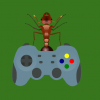If images don't load, just link an image of at least one caste of the species in question. Worst case scenario, the reader can just look up the species and find google images.
REGION: TEXAS'
SPECIES: Atta texana.
QUEEN IMAGE:
MAJOR IMAGE (OPTIONAL):
(MINOR) WORKER IMAGE:
APPEARANCE DESCRIPTION: Red ranging from very dark to very bright, heads are wide with eyes close to the mandibles. Queens and males look very similar, but queens have large heads.
FOUNDING (CLAUSTRAL? POLYGYNOUS?) A claustral ant, A. texana queens bring a fungal pellet from their host colony into their founding chamber while they raise brood.
DIET (OPTIONAL): Workers must forage for dried leaves, which they bring back as food for the fungus they cultivate and eat.
BEHAVIOR: Workers will go very far to find leaves. They may not accept moist ones. Take care to properly remove parasites and disease from leaves by boiling or freezing.
OTHER NOTES: Do not heat the leafcutter ants, as this could kill their fungus.
If pictures do not load, view all female castes here.
Do note species is A. cephalotes, not A. texana.
Edited by The_Gaming-gate, March 27 2024 - 5:39 PM.


















